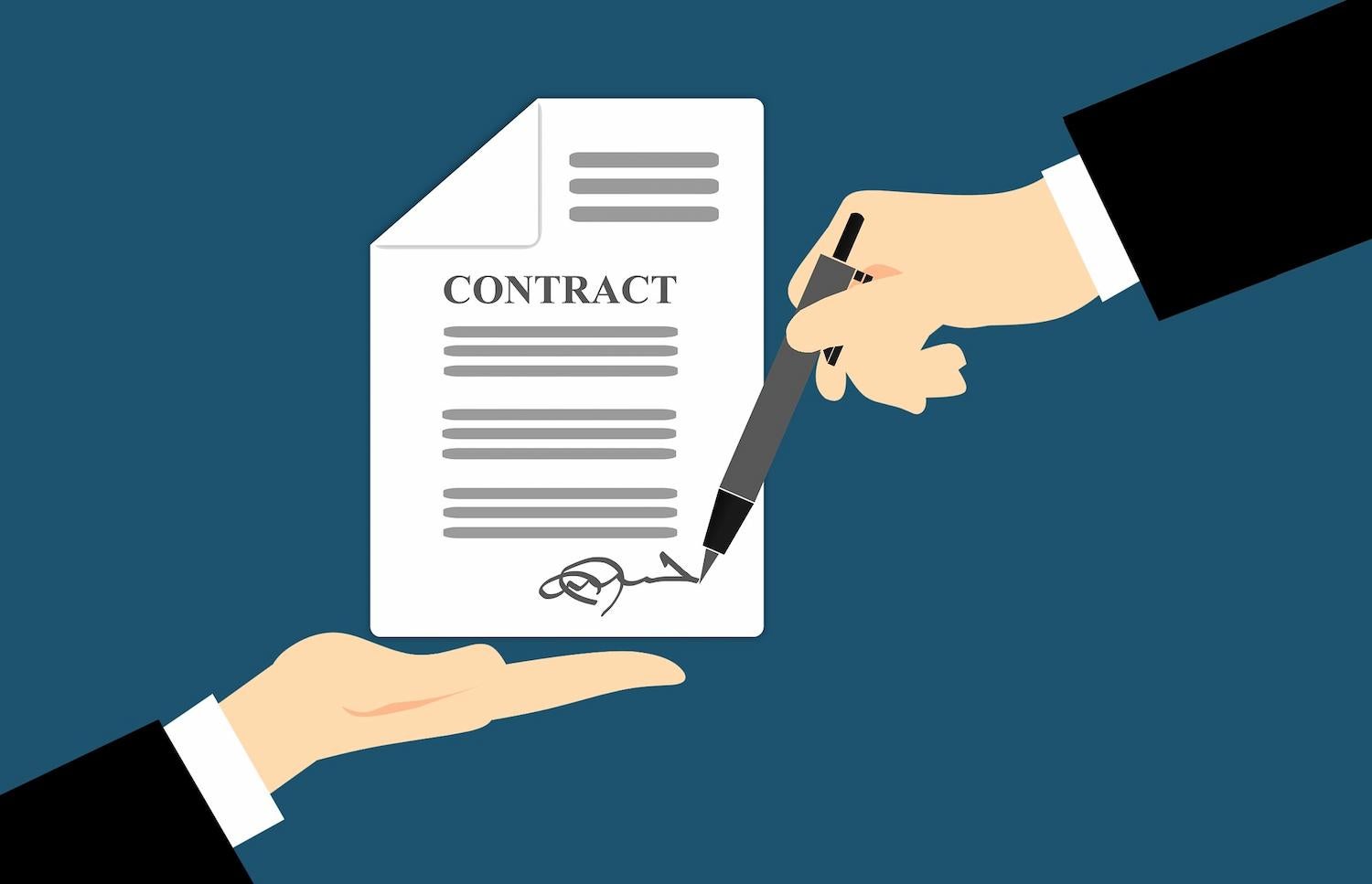Outsourcing comes in handy for many different businesses of all sizes and industries. By contracting out work to third parties, organisations can focus on developing their business, making informed decisions and acquiring new customers. At the same time, they can be sure that other tasks are being handled by experts specialised in given areas. Fewer distractions, more focus.
However, no matter how good of a deal you’ve got with your outsourcing team, you always have to come up with an outsourcing agreement to ensure all the crucial elements.
Time spent on negotiation and drafting is time well spent. By ensuring all the details beforehand, you can not only create a good working relationship based on mutual benefit but also avoid possible conflicts along the way.
What Is an Outsourcing Contract?
Let’s start from scratch. An outsourcing contract is a legal document that ensures all the most important elements of an outsourcing project. It describes in detail what work will be handled by the third party, what expectations and requirements you have, and what deadlines should be achieved. It protects both parties.
Speaking of protection, outsourcing contracts handle numerous legal issues, such as intellectual property rights, the protection of confidential information, and indemnities to keep you, and your outsourcing partner safe and sound.
There are three main types of outsourcing contracts that you may want to consider: fixed price, target cost contract, and time and materials contract. If you want to find out more about the types of outsourcing contracts, make sure to check out this article.
Key Elements of an Outsourcing Contract
Outsourcing comes with great advantages for your company, but you need to secure cooperation both for your business, as well as for your outsourcing partner. It’s always better to be safe than sorry, as not having a fail-safe contract may cost you a lot of money and time. However, remember that the fail-safe contract has the biggest chance of success when it’s tailored to the needs of your IT project. Choosing a random template from the Internet can do more harm than good.
To help you create an outsourcing contract, I have prepared a thorough guide for anybody considering outsourcing. Take a look at it to learn important information about the legal and technical aspects of outsourcing agreements.
Detailed Project Scope
You have to start somewhere; in the case of an outsourcing contract, I advise you to define a project scope first. Project scope is the part of project planning that involves determining and documenting a list of specific project goals, deliverables, tasks, costs and deadlines.
It explains the boundaries of the project, establishes responsibilities for outsourcing team members and sets up procedures for how completed work will be verified and approved, as well as handed over to you.
You should never underestimate the importance of a well-thought and detailed project scope. Project Scope can be an annexe to the contract, especially if it is extensive or may change over time. Thanks to this, it will not be necessary to amend the agreement whenever the Parties decide to update the scope of services. Moreover, it's always good to have the so-called change requests management procedure, which clearly describes whether changes are possible, how they affect the budget and schedule, and who on both sides can make decisions about changes (who requests, who approves, can it be by one of the companies only).
And one more thing. By default, the IT service provider is liable for diligent operation - and if you want it to be responsible for the result, you must clearly enter such obligations in the contract.
Transfer of Assets
When working in an outsourcing model, sometimes several IT assets, such as telecommunications equipment, computer hardware, equipment leases, and software licensing must be transferred. In the case of smaller or less formalised ordering parties, it is rather an exception to the rule, as nowadays, software houses usually provide the client with specialists and basic workstation equipment.
The devices are usually sent to the supplier in two cases:
- when this results from the contracting authority’s security standard (i.e., you can only log into their network from specific devices, e.g., their computers, based on a specific MAC address)
- when providing certain IT services requires some highly specialized equipment that a typical software house may not have.
To legally bind the transfer and return procedure of these assets to the outsourcing business, you need to prepare an asset transfer clause.
NDA
One of the biggest concerns for clients choosing to outsource is that their intellectual property, such as their ideas, would be stolen if they share them with an outsourcing company. No wonder, your IP is what distinguishes you on the market and you should protect it at all costs. In order to do so, you need to follow some simple rules. First of all, before signing a contract with a vendor, do thorough research on them. Go through their reviews and social media and use the power of the word of mouth to get all the information you need to assess their credibility and reliability. After this initial background check, schedule an appointment to lay the groundwork for collaboration and enquire about their processes, as well as compliance.
Once you make sure that you’re dealing with a reliable company, create a non-disclosure agreement (NDA) to establish a confidential relationship. By doing so, you ensure that sensitive information your outsourcing partners may obtain will not be made available to any others. NDA usually has several clauses and one of them states that the fact of disclosing certain confidential information to the other party does not have consequences such as granting a license or transfer of copyright and cannot be understood or interpreted as such.
Data Protection
Outsourcing services require you and your outsourcing partner to share and access confidential information. To ensure information security, you and the outsourcing company must comply with the laws in your regions, such as GDPR in the EU or HIPAA in the USA.
Before starting cooperation with your outsourcing partner, make sure to thoroughly research the subject of data protection compliance in the regions your businesses operate in. It’s essential if you choose to offshore. Make sure the contract requires compliance with industry best practices, such as ISO 27000 standards, PCI Data Security Standard or the Control Objectives for Information and related Technology (COBIT). Last but not least, to secure all the data, make sure to write down all compliance requirements.
Ownership Of Product
Every business wants to have total control over property rights and the finished product. However, in some outsourcing arrangements, the vendor and the company that outsources IT services may share ownership of the software developed. This may happen in many configurations, such as when:
- an outsourcing company customises its current software or creates an expansion of the existing software (the existing IP will be joined by the new IP generated by the provider),
- a company as a supplier is to provide maintenance and development services for a product produced by another company and only has a license for it. In this scenario, three groups of works may get mixed up - the original system, previous development results, and new development results (from the supplier currently involved).
What the supplier does and makes available to the client is not only theirs, so in the area of intellectual property, there is a whole ecosystem of different licenses, rights, dependencies, etc. For example, the client orders the development of a website based on an existing engine. The engine belongs to one entity, the results of development works belong to the supplier, and the content published on the website - to the customer. This may also include e.g., a hosting / SaaS license, a database or database engine license, etc.
However, whether you're getting a completely new software developed or just modernising or servicing your product, outsourcing agreements should explicitly state the ownership to avoid any future conflicts.
Dispute Resolution
Sometimes things in the project go sour. If the outsourcing partner breaches your contract, you may be forced to take legal action which might drain necessary resources. However, you can preserve your company from that.
By describing an amicable resolution provision, you can avoid getting caught up in complicated legal issues. It’ll allow both companies to negotiate and come to a mutual agreement about the situation, minimise the risk of conflict and provide you with an easy, understandable action plan in case of any problems.
In terms of dispute resolution, there are two basic decisions to be made in the contract:
- Which legal system will be appropriate to interpret and review the contract and settle any dispute (i.e. the Choice of Law Clause)?
- In what mode will the dispute be resolved? Here are four popular methods: amicably (negotiations), mediation (or other so-called alternative dispute resolution, ADR), arbitration (another ADR procedure, performed by a panel of professional arbitrators that does not constitute a public judiciary court) or a court of law.
It’s also important to establish "whose" common court, arbitration body or mediator will be designated by the contract to deal with such a topic (whether the contracting authority’s or its country or the contractor’s or its country).
End Note
By incorporating the elements described above, you can create an outsourcing agreement that aligns with your organisation's requirements and needs and helps achieve your project's goals.
However, to secure the quality of cooperation and achieve the best possible results, you must first choose a trusted and experienced outsourcing partner. By choosing a valued partner, you can breathe a sigh of relief and be more assured of productive cooperation that is both fair and well-defined according to the contract.

